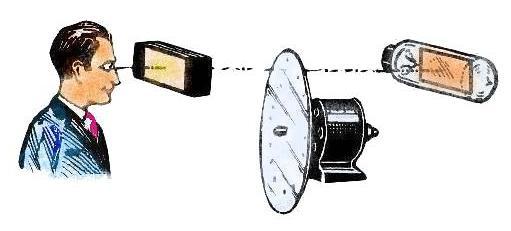
The Big Catch
The Fish That Got Away.
Once, long ago, pulling in live television from a distant city or country was a thrill beyond parallel. Add to that thrill the joy of receiving pictures on a set that you and Grandfather built! Today, of course, the great mechanical television transmitters are rusting scrap metal. But the shortwaves remain, and as the evening sky darkens, it teems with distant radio transmissions.Picture Characteristics.
Most early television systems reproduced pictures with 24 to 60 lines. This definition produced useful, but coarse-grained pictures. A typical receiver with a Nipkow scanning disc could display pictures an inch and a half across. The pictures tended to be keystone-shaped, rather than rectangular. A neon glow tube recreated gray tones in the image. The tube lent its quaint, orange patina to the light areas in the picture. Experiments with other gases made color possible by 1928. Regardless, most broadcasts stuck to black-and-white, or more properly, black-and-orange pictures.What the Viewer Saw
resembled a moving newspaper halftone. While viewers could readily detect picture grain, the motion canceled out some of the grain. Some deluxe television sets included a magnifying lens. This lens could enlarge the image to postcard size, but also accentuated scan lines.What Low-Res Pictures Offer
Another Way
of thinking about mechanical television pictures is that they duplicated the detail of today's computer icons. Of course, unlike computer graphics, mechanical television was an analog medium. Mechanical television pictures' gray scale was vastly superior to what computer icons offer. A television picture could display an unrestricted number of grays.Closeups.
Even the lowest-resolution mechanical television pictures could convey recognizable closeups of faces. As definition increased to 60 lines, useful medium shots and two-shots became possible. A long shot at 60 lines could even reproduce an entire baseball diamond. However, much as with today's television, this long shot would lose details of individual players.Speaking of Baseball:
Comparing 60-line and earlier 24-line pictures is difficult. Each is in its own ballpark, even though outwardly similar mechanical devices produced the pictures. The 60-line picture provides over six times as much picture detail. By the way, today's NTSC television involves 40 times as much detail as a 60-line picture.Moonlighting with TV
Nighttime Television DX.
Today's television is a line-of-sight medium. We receive faraway telecasts by satellite, microwave or coaxial cable, rather than by direct broadcasts. Mechanical television was a different story. For several years, mechanical television transmitters operated on the shortwave frequencies. These special frequencies travel vast distances across the earth. Shortwave transmission made possible direct reception over hundreds or even thousands of miles. Under normal conditions, contemporary broadcast television still can't match this feat.Development
Larger Pictures.
About 1932, manufacturers began offering smaller sets with larger pictures. In this type set, a lens disc replaced the aperture disc of earlier production. A lens disc and crater neon tube could project images two feet across. Lens discs also made theatrical television possible. Typical theatrical installations paired the lens disc with an arc lamp and Kerr Cell or a Taylor tube.The 60-Line Barrier.
Some television history books claim that mechanical television ended with 60-line pictures. These books often assert that a mechanical device isn't capable of high-resolution video. Neither statement is accurate. True, most amateurs dropped out of the hobby when the line count exceeded 60. A 60-line aperture disc to support 1.5-inch pictures measured 31 inches in diameter. Yet each scanning hole was a mere two hundredths of an inch across. These specifications challenged the most precise amateur builder. Lens discs were even more difficult to construct.As Technology Forged Ahead
, it left amateur builders behind. Still, manufacturers eventually produced large-picture, 180, 240 and even 405-line mechanical receivers. Today, mechanical scanners can output high-resolution imagery.Go to Page: 1 2 3 4 5 6 Next
Page Directory
The Big Catch —The Fish That Got Away —Picture Characteristics —What the Viewer Saw —What Low-Res Pictures Offer Another Way —Closeups —Speaking of Baseball Moonlighting with TV —Nighttime Television DX —Development Larger Pictures —The 60-Line Barrier —As Technology Forged Ahead